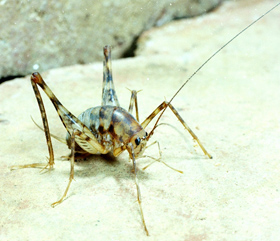Diestrammena asynamora
Greenhouse Camel Cricket
Synonym(s): Tachycines asynamorus, Spider Cricket and Greenhouse Stone Cricket
Class: Insecta
Order: Orthoptera
Family: Rhaphidophoridae

Photographer: Michael Waldvogel
Source: Univar, Inc.
Description
Adult Description: The Greenhouse Camel Cricket (Diestrammena asynamora) measures 13-15 mm, and can range in color from pale to dark brown with darker brown regions on the dorsal posterior region. The adults have large antennae extending two times the length of the body.
Larva Description: Due to the nocturnal behavior and minimal ecological threat little is known about the Greenhouse Camel Cricket larval stage.
Host Plant: None
Ecological Threat: Diestrammena asynamora prefers artificial environments and will feed on various greenhouse plants causing large scale damage if not treated. During warmer season months or in the south the Greenhouse Camel Cricket will feed in outdoor gardens, causing the most damage to small seedlings. The Greenhouse Camel Cricket moves indoors during cold weather, where it feeds on various household items such as clothes and house plants.
Biology: Due to the nocturnal behavior and minimal ecological threat little has been researched about the Greenhouse Camel Cricket reproduction. However, it is believed the reproduction is similar to most other crickets within the family Rhaphidophoridae.
History: The Greenhouse Camel Cricket is currently found in Europe, Asia and North America. It is believed that the Greenhouse Camel Cricket spread from Asia to the United States in the 1900's via freight or luggage transport.
U.S. Habitat: The Greenhouse Camel Cricket is found in artificial environments such as greenhouses or similar man-made places where they can scavenge for food. As an opportunistic feeder the Greenhouse Camel Cricket will eat various organic material that is dead or alive.
Distribution
Native Origin: Asia
U.S. Present: Found in all states.
Resembles/Alternatives
Management
The Greenhouse Camel Cricket can be treated with general pesticides recommended for common cricket species. Pesticide soap called Safers and insect dust containing diatomaceous earth and boric acid have been found effective at treating several species of crickets.
SEARCH Online
Google Search: Diestrammena asynamora
Google Images: Diestrammena asynamora
NatureServe Explorer: Diestrammena asynamora
Bugwood Network Images: Diestrammena asynamora
References
Blatchley, W.S. 1920. Orthoptera of North-Eastern America. Indianapolis, 785pp.
Kim, J., T.W. Kim. 2007.Taxonomic Study of Korean Stenopelmatoidea (Orthoptera: Ensifera). Entomological Research. 32 (3) 141-151.
Internet Sources
http://bugguide.net
http://www.mobot.org
 Texas Invasive Species Institute
Texas Invasive Species Institute